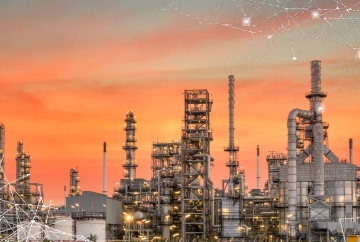#8 Data, Analytics, and Reporting
With a vast amount of structured data generated from SCADA systems, surface and sub-surface process control data, and time-series production data, analytics automation can inject efficiency gains into the production process, refinery efficiency and ultimately improve the profitability of overall operations. However, reporting processes are currently being run in manual mode, and extracting data from disparate systems to collate them in one place brings redundancy into an otherwise automatable process.
Reporting automation is an easy-to-implement use case that can be leveraged to generate customized reports for various stakeholders at regular intervals, ultimately bringing learnings and insights into action in the oil and gas industry.
#9 Workplace Safety
The oil and gas industry is replete with high-risk processes where manual intervention leads to hazardous incidents even in the most controlled and monitored environments. However, automation of these high-risk processes in the rig construction, drilling, and fracking stages can help eliminate the need for human intervention.
In addition, connected wearable health devices and cameras, and drones augmented with image recognition technology can be leveraged to improve workplace safety by alarming in case of hazards. Environmental monitoring solutions can alert onsite employees proactively to avoid hazards before they occur.
#10 Pricing
With the demand for oil and natural gas peaking in 2030 and reducing after that, the need for maximizing gains on each barrel has become critical. However, a lack of pricing guidelines during deals and complex contractual arrangements render legacy cost + margin - based pricing models ineffective. However, by using strategic price management tools powered by real-time market variables and delivery of deal-specific price guidance and incentive pitches to sales staff, oil and gas companies can
achieve over 2% higher annual returns.
Such toolsets also internalize mix analysis, rationalize input costs across multiple parties, thereby securing the pricing perimeters within profitable ranges, even when the markets fluctuate and demand levels waver unpredictably.
#11 Order Processing
Most oil and gas companies are characterized by siloed operations when it comes to ordering fulfillment. What complicates order management processes further is that paper-based processes create the need for multiple back-and-forths to confirm production levels, volume commitments across deals, and a healthy flow within the downstream supply chain.
However, most tasks within these processes lend themselves well to automated execution through RPA bots - for example, order capture, billing, credit/debt management, shipment order accuracy, and shipment documentation and status tracking can be completely automated, thereby eliminating inaccurate orders, reducing costs, near-complete transaction accuracy, and nearly 40% productivity gains.
#12 Pipeline Monitoring and Surveillance
Gas pipeline construction and maintenance projects can often turn into a cost black-hole when regular field visits and inspections call for multiple trips and the inability to respond to fast compounds losses. However, IoT devices tethered via LPWAN networking can deliver real-time asset data such as cracks, wall thickness, flow rates, and external data such as soil pH, resistivity, humidity, and moisture levels to rules-configured monitoring systems.
Armed with real-time status of the pipelines and automated monitoring and maintenance triggers, zero inspection trips, and instantaneous response to incidents can deliver big savings for downstream oil and gas players.
#13 Lease Record Management
In the oil and gas industry, most documents still exist on paper. Because these documents are digitized to add up to unstructured data ultimately, automated document management systems are a must-have to keep track of lease termination, renewals, land files, property files and contracts outlining terms of joint ventures, and other critical documents. Otherwise, back-office workers end up under paperwork, and legal expenses can hamper an otherwise profitable venture.
Automated lease record management is all the more critical for global players with operations spanning across multiple geographies and legislations, where leases must be digitized to avoid legal conflicts and interruptions to operations.
#14 Asset Management
Upstream and mid-stream oil and gas companies rely on thousands of expensive assets in orchestrating production, refining, and transportation. As a result, a comprehensive asset management platform that automates and standardizes acquisition, operation, maintenance, and decommissioning of assets with complete visibility across multiple sites is a key element of operational excellence, making the operations resistant to market volatility improving profitability.
Asset management automation platforms also integrate with predictive maintenance solutions, bring seamless asset management that results in enhanced performance, and maximize the value of capital expenditures for O&G businesses.
#15 Procure to Pay Automation
Because the oil and gas industry brings unique constraints in the Procure-to-Pay cycle, standardization is central in P2P automation. The Petroleum Industry Data Exchange standards enable a streamlined exchange of technical data points that enable O&G companies to automate their P2P processes, injecting efficiency in the process while reducing invoice clearing times and backlogs.
P2P excellence is also critical for maintaining cost competitiveness, and automation can bring promising results while improving profitability for upstream, midstream, and downstream players.





